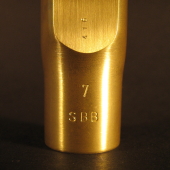Why Baffle-free? - Why would you want a baffled mouthpiece anyway?
Let's get down to answering this 'cosmic' question: Why Baffle-free?
As most of you already know, I had spent several years studying and learning the so-called 'secrets' of mouthpiece construction and design with the late great Mr Ralph Morgan. Mr Morgan, was one of the greatest mouthpiece makers who also knew that correct acoustic design would not allow any kind and/or form of wedge, constriction and/or baffle.
The baffle, or wedge has now become a cheap and fast way to produce loud and bright mouthpieces that 'appear' to play; in other words, the use (or misuse) of baffles will aid the uninformed manufacturer to create a loud and bright mouthpiece that will play a few notes loudly, brightly while the rest of the range is 'choked, impeded, muffled, strained, does not respond to light air streams and does not articulate well'.
So why do so many other manufacturers use baffles, if baffles are so bad?
Before I can begin to answer this question, let's take a journey down 'memory lane'. I would like to talk about the famous vintage Florida links of yesteryear: These mouthpieces can also be classified as 'baffle-free'. The reason that some of these are so highly sought-after is due to some of these 'random' mouthpieces having the perfect combination of constuction material and design geometry. This 'synergistically' creates an overall sound effect of amplification that then corresponds tonally as'brilliance', power, projection and volume; all these amazing attributes in a baffle-free package ie without a baffle and/or wedge.
I say 'some' Florida Links because not 'all' Floridas will play; on the contrary some Floridas can be quite stuffy and unresponsive.
So why do some of the Floridas play so well?
I previously mentioned that one of the critical design parameters was construction material. This single parameter played a vital role as to whether a 'Florida' was going to become a 'collectible' 30 years later - or not!
The 'grain modifier' that determined whether 'Internal Resonance' could occur in the case of Florida Links was the quantity of Lead (Pb) within the alloy. With laboratory analysis I have determined that the nominal amount of lead within the brass for the 'killer mouthpieces' is 3.5 to 4% (no pun intended). I also tested many 'Florida' mouthpieces that did not play. These ended up having anywhere around 1-1.8% Pb. It immediately became evident that Lead (Pb) was a valuable precursor to acoustical resonance (or natural acoustic amplification). It was not so much that the Lead was resonant (since Lead is a 'dead' material) but more to the point the 'grain modification' that results from the 'impeded grain growth' - Lead in such quantities is insoluble in Copper.
It is my assumption that this variation in Lead quantity within the alloy was purely unintentional, since so many Floridas deviated from this 'optimized' amount - nominally 3.7%. My scientific approach and analysis has determined that the Lead content is the main 'causal link' to great playing Florida links. Of course, finishing details are one other determining parameter (oftentimes refacers ruin a couple of 'hidden' parameters by removing valuable material that controls another very important parameter called Internal Resonance Coefficient (IRC) - why don't refacers add material?[that's another news story altogether for another time!]
Synopsis: Curiously, most current makers/manufacturers are in the 'blind' belief that material has nothing to do with 'how a mouthpiece plays and/or functions'. As long as this 'narrow-minded' belief-system prevails in this rather small 'cottage industry', the possiblity of science improving the humble saxophone mouthpiece will strictly be limited to the 'believers' of 'baffle-free' mouthpiece technology.
Again, our SBB product is living proof that it is possible for a baffle-free design to have brilliance, projection and power, albeit without any compromise whatsoever to intonation, response and eveness of registers. I do not use Lead (Pb) in order to increase the Internal Resonance Coefficient (IRC) of our specialized bronze and Vibralloy™; instead, proprietary 'crystal growth techniques' and hi-tech metalurgical 'crystal seeding techniques' are utilized. (This latter technology is also used to manufacture jet engine turbine blades - more info on this subject will be added in a later article).
Remember: The original sax mouthpiece that was invented/created by Adolphe Sax (the original inventor/creator of the saxophone) was baffle-free, and as good acoustical design would dictate, the original equations do not permit that baffles be incorporated into a sax mouthpiece per se. DZ.
|

